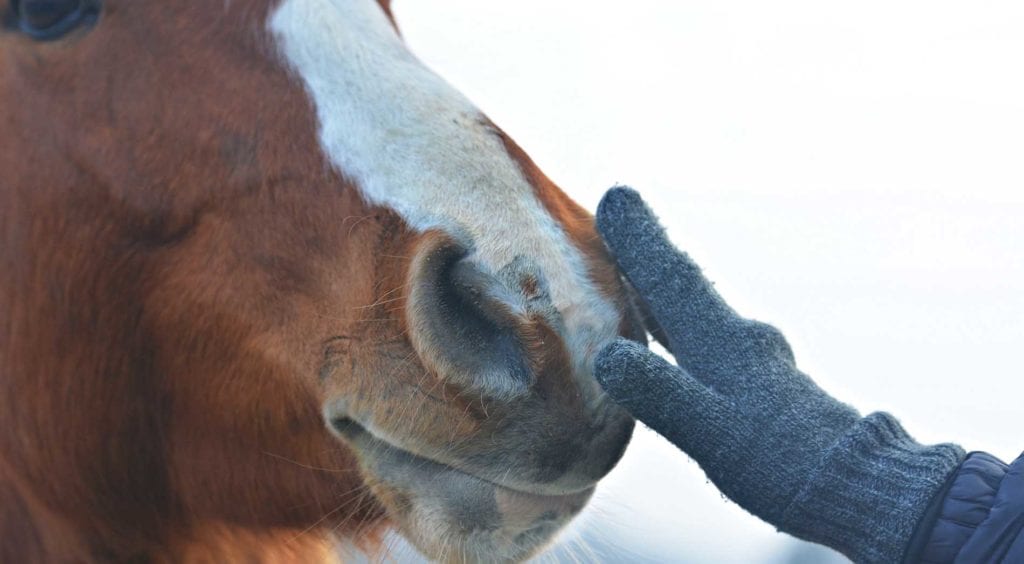Winter weather can be fickle and harsh in southwestern South Dakota. From Rapid City near the Black Hills to Interior near the Badlands, the average high hovers around 35 degrees Fahrenheit and the low around 10. But record highs are in the 60s and lows in the minus 20s. It can be tough on horses, whether they are in a barn or on the range.
The up and down, freeze and warm, freeze and warm—it works their system pretty hard,” says Neal Livermont of Livermont Quarter Horses near Interior.
“You wake up in the morning and ask, ‘Is the wind blowing?’ “ says Patty Brunner of Brunner Quarter Horses in Rapid City. “It can be four degrees, but if there’s no wind, it’s almost a pleasure!”
But both the Livermonts and the Brunners know that horses can take the weather with or without a barn if they are prepared for it. Here’s how these stockmen handle the challenge of getting feed, shelter and water to their horses in a Dakota winter.
Show Barn
Feed
A day at Brunner Quarter Horses begins well before dawn with the morning feeding. The show horses and youngsters in the barns get different grain and hay rations—mostly grass and some alfalfa—depending on the individual.
They are fed four times during the course of the day, the last around 9:30 p.m. “I’m not a big grain feeder,” Patty says. “A horse is a forager. If you can keep their intestines and stomach full, you decrease your incidence of colic, and they use their feed better.
“A horse’s heat really comes from the digestion of roughage, your hay. In colder weather, we up the quantity of hay they get, especially those outside.”
Her husband, Don, warms up the skid loader in the morning and rolls out big bales of hay for the pasture mares, enough for each to have about 30 pounds. Don and Patty also have their hay tested for its mineral and protein content so they know if and where it needs supplementing.
Shelter
“A horse can withstand a lot if they can get out of the wind,” Patty says. As a rule, they don’t blanket pasture horses. “Mother Nature created a hair coat with layers in it, and if you mat that down, you’re taking away an insulating factor in the hair,” Patty says.
The horses kept in the barn have their blankets pulled during turnout regardless of the weather. Patty “has a thing” about them catching their blankets on something.
Water
Making sure a horse is drinking enough can be difficult, especially out on pasture. Don and Patty use tank heaters, the type that screws in the bottom of the tank.
“Some old-timers would say a horse is going to make it if there’s snow on the ground,” Patty says. “But (our horses) are fed dry feed, and if they don’t take in water, that’s when your colic increases.”
They carry buckets to the horses in the barns twice a day. “We don’t leave so much that the bucket is solid ice,” Patty says. One crucial element to keeping the water running at their place is a generator.
Open Range
Shelter
The Livermont Quarter Horses roam “the draws,” the open range and cedar draw badlands south of the White River. To the north, across the river, lies Badlands National Park, known as the “bald badlands” because of the lack of cedars in them. The country is rough, and horses are a necessity for working cattle in it.
“The badlands will build some character,” Neal says with a smile, and he means in horses as well as people. He has broken his pelvis taking a tumble off a young horse down a cedar draw.
But the shelter of the cedars and badlands is a blessing in the winter wind.
“In the draws, it’s just like being in a barn,” Neal says. “You can lie down and take a nap in a blizzard and never know it was a blizzard.”
Feed
The Livermonts feed a high-protein feed to all the horses (in the barn and on the range) and supplement the weanlings with a “milk plus” product. They also provide free-choice salt mineral to everything.
The horses continue to graze as the winter drags on, and they are supplemented with the ranch’s choicest oat hay.
“We’re more into haying,” Neal says of the ranch’s farming ground. “It seems like with a grain crop, you can go one direction, and that’s through the market or store it. With hay you have more options—buy calves and feed it, sell it outright, etc. And it tastes really good in a snowstorm.”
Water
Getting the animals water is Neal’s biggest concern when the temperature drops.
“We check the tanks every day to make sure they’re working,” he says. “We put cement lids on the tanks, and they’ve got two holes in them. We put baler belts around the inside of it, and that keeps the wind from blowing back on the float so it doesn’t freeze up. Then all you have to do is break out one hole. It’s got to get down to single digits before it’ll freeze.”
Snow has been scarce the past few winters, and that’s not good.
“Normally, we get a pretty good snow, but the last six to seven years, we haven’t gotten hardly any, and that’s what we depend on to fill our dams,” Neal says. “A lot of the springs here are starting to dry up. “It’s tough when we have to work the pumps hard to keep the water running and (then) pay that electric bill.”

